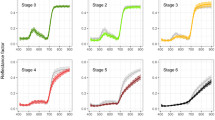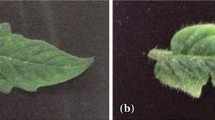Abstract
Cassava Mosaic virus Disease (CMD) is the most severe and widespread virus infection that affects cassava (Manihot esculenta Crantz) crops. This paper investigates the application of photochemical reflectance index (PRI) imaging to detect and assess the impact of varying levels of CMD infection in cassava. Towards this, narrow band reflectance images of field-grown cassava plants were recorded at 531 and 571 nm by proximal sensing with a multispectral imaging system (MSIS). It was observed that the PRI values increase with increasing levels of CMD infection in all the varieties of cassava studied. A scatter plot of the PRI image intensity yielded a sensitivity of 85 % and specificity of 79 % for discriminating visibly no CMD from initial CMD and a sensitivity of 93 % and specificity of 92 % for discriminating initial CMD from advanced CMD. Area under the receiver operator characteristics (AUC-ROC) curve was used to discriminate the CMD infection level by differentiating visibly no CMD from initial CMD [AUC = 0.92] and initial CMD from advanced CMD [AUC = 0.99]. It was observed that PRI values determined from the experimental data follow a linear inverse relationship with net photosynthetic rate (Pn) (R 2 = 0.76) and total leaf chlorophyll (Chl) content (R 2 = 0.80). The results show that PRI imaging can be utilized to discriminate healthy plants from CMD and other stress infected crops by proximal sensing in outdoor plants.







Similar content being viewed by others
References
Arnon, D. I. (1949). Copper enzymes in isolated chloroplasts and polyphenol oxidase in Beta vulgaris. Plant Physiology, 24, 1–15.
Ayanru, D. K. G., & Sharma, V. C. (1982). Effects of Cassava Mosaic Disease on Certain Leaf Parameters of Field-grown cassava clones. Phytopathology, 72, 1057–1059.
Barrs, H. D., & Weatherley, P. E. (1962). A re-examination of the relative turgidity technique for estimating water deficit in leaves. Australian Journal of Biological Sciences, 15, 413–428.
Bilger, W., & Bjorkman, O. (1990). Role of the xanthophyll cycle in photoprotection elucidated by measurements of light- induced absorbance changes, fluorescence and photosynthesis in leaves of Hedira canariencis. Photosynthesis Research, 25, 173–185.
Black, C. A. (1965). Methods of soil analysis: Part I Physical and mineralogical properties. In American Society of Agronomy. Madison, Wisconsin: USA.
Carter, G. A. (1994). Ratios of leaf reflectance in narrow wavebands as indicators or plant stress. International Journal of Remote Sensing, 15, 697–703.
Carter, G. A., & Miller, R. L. (1994). Early Detection of Plant Stress by Digital Imaging within Narrow Stress-Sensitive Wavebands. Remote Sensing of Environment, 50, 295–302.
Deery, D., Jimenez-Berni, J., Jones, H., Sirault, X., & Furbank, R. (2014). Proximal remote sensing buggies and potential applications for field based phenotyping. Agronomy, 5, 349–379.
Demmig-Adams, B., & Adams, B. (1994). The role of xanthophyll cycle carotenoids in the protection of photosynthesis. Trends in Plant Science, 1, 21–26.
Esau, K. (1956). An anatomical view of virus disease. American Journal of Botany, 43, 739–748.
Fang, Z., Bouwkamp, J., & Solomos, T. (1998). Chlorophyllase activities and chlorophyll degradation during leaf senescence in non-yellowing mutant and wild type of Phaseolus vulgaris L. Journal of Experimental Botany, 49, 503–510.
Filella, I., Porcar-Castell, A., Munne-Bosch, S., Back, J., Garbulsky, M. F., & Penuelas, J. (2009). PRI assessment of long-term changes in carotenoids/chlorophyll ratio and short-term changes in de-epoxidation state of the xanthophyll cycle. International Journal of Remote Sensing, 30, 4443–4455.
Gamon, J. A., Peñuelas, J., & Field, C. B. (1992). A narrow-wave band spectral index that track diurnal changes in photosynthetic efficiency. Remote Sensing of Environment, 41, 35–44.
Gamon, J. A., Serrano, L., & Surfus, J. S. (1997). The Photochemical Reflectance Index: An optical indicator of photosynthetic radiation use efficiency across species, functional types and nutrient levels. Oecologia, 112, 492–501.
Ibaraki, Y., Matsumura, K., & Gupta, S. D. (2010). Low Cost Photochemical reflectance index measurements of micro propagated plantlets using image analysis. Computers and Electronics in Agriculture, 71, 170–175.
Mandal, M., Saravanan, R., & Maiti, S. (2008). Effect of different levels of N, P and K on downy mildew (Peronospora plantaginis) and seed yield of isabgol (Plantago ovate). Crop Protection, 27, 988–955.
Nakaji, T., Oguma, H., & Fujinuma, Y. (2006). Seasonal changes in the relationship between photochemical reflectance index and photosynthetic light use efficiency of Japanese larch needles. International Journal of Remote Sensing, 27, 493–509.
Nichol, C. J., & Grace, J. (2010). Determination of leaf pigment content in Calluna vulgaris shoots from spectral reflectance. International Journal of Remote Sensing, 31, 5409–5422.
Palta, J. (1990). Leaf chlorophyll content. Instrumentation for studying vegetation canopies for Remote Sensing in Optical and Thermal Infrared Regions. Remote Sensing Reviews, 5(1), 207–213.
Panigada, C., Rossini, M., Meroni, M., Cilia, C., Busetto, L., Amaducci, S., Boschetti, M., Cogliati, S., Picchi, V., Pinto, F., Marchesi, A., & Colombo, R. (2014). Fluorescence, PRI and canopy temperature for water stress detection in cereal crops. International Journal of Applied Earth Observation and Geoinformation, 30, 167–178.
Patil, B. L., & Fauquet, C. M. (2009). Cassava mosaic geminiviruses: actual knowledge and perspectives. Molecular Plant Pathology., 10(5), 685–701.
Penuelas, J., Gamon, J. A., Fredeen, A. L., Merino, J., & Field, C. B. (1994). Reflectance indices associated with physiological changes in nitrogen- and water-limited sunflower leaves. Remote Sensing of Environment, 48, 135–146.
Penuelas, J., Filella, I., & Gamon, J. A. (1995). Assessment of photosynthetic radiation use efficiency with spectral reflectance. New Phytologist, 131, 291–296.
Penuelas, J., Llusia, J., Pinol, J., & Filella, I. (1997). Photochemical reflectance index and leaf photosynthetic radiation use efficiency assessment in Mediterranean trees. International Journal of Remote Sensing, 18, 2863–2868.
Raji, S. N., Ravi, V., Saravanan, R., Subhash, N., Makeshkumar, T., Nita, S. & Renju, U. A. (2013), Assessing cassava mosaic virus infection in cassava plants using PRI imaging. Proceedings of National Symposium on Pathogenomics for Diagnosis and Management of Plant Diseases, Thiruvananthapuram, India, October 25–26.
Raji, S. N., Subhash, N., Ravi, V., Saravanan, R., Mohanan, C. N., Nita, S., & Makeshkumar, T. (2015). Detection of mosaic virus disease in cassava plants by sunlight-induced fluorescence imaging: a pilot study for proximal sensing. International Journal of Remote Sensing, 36(11), 2880–2897.
Richardson, A. D., & Berlyn, G. P. (2002). Spectral reflectance and photosynthetic properties of Betula papyrifera (Betulaceae) leaves along an elevational gradient on Mt. Mansfield, Vermont, USA. American Journal of Botany, 89, 88–94.
Richardson, A. D., Berlyn, G. P., & Duigan, S. P. (2003). Reflectance of Alaskan black spruce foliage in relation to elevation and latitude. Tree Physiology, 23, 537–544.
Subhash, N., Mohanan, C. N., Rupananda, J. M., & Muralidharan, V. (2004). Quantification of stress adaptation by laser-induced fluorescence spectroscopy of plants exposed to engine exhaust emission and drought. Functional Plant Biology, 31, 709–719.
Terry, E.R. (1975). Description and evaluation of cassava mosaic disease in Africa. Proceedings of Interdisciplinary workshop held at IITA, Ibadan, Nigeria, 75, 53–54.
Thresh, J. M., Fargette, D., & Otim Nape, G. W. (1994). Effects of African cassava mosaic geminivirus on the yield of cassava. Tropical Science, 34, 26–42.
Tu, J. C., Ford, R. E., & Krass, C. J. (1968). Comparison of chloroplasts and photosynthetic rates of plants infected and not infected by maize dwarf mosaic virus. Phytopathology, 58, 285–288.
Whitehead, D., Boelman, N. T., Turnbull, M. H., Griffin, K. L., Tissue, D. T., Barbour, M. M., Hunt, J. E., Richardson, S. J., & Peltzer, D. A. (2005). Photosynthesis and reflectance indices for rainforest species in ecosystems undergoing progression along a soil fertility chronosequence in New Zealand. Oecologia, 144, 233–244.
Acknowledgments
This work was carried out as part of a collaborative project between National Centre for Earth Sciences (NCESS), Thiruvananthapuram and Central Tuber Crop Research Institute (CTCRI), Thiruvananthapuram with grants from the NCESS Plan-289 project. The authors are thankful to the Directors of NCESS and CTCRI, the project assistant (Renju Appukuttan), and the technical staff involved in the work for their encouragement and support. RSN acknowledges NCESS for her research fellowship.
Author information
Authors and Affiliations
Corresponding author
About this article
Cite this article
Raji, S.N., Subhash, N., Ravi, V. et al. Detection and Classification of Mosaic Virus Disease in Cassava Plants by Proximal Sensing of Photochemical Reflectance Index. J Indian Soc Remote Sens 44, 875–883 (2016). https://doi.org/10.1007/s12524-016-0565-6
Received:
Accepted:
Published:
Issue Date:
DOI: https://doi.org/10.1007/s12524-016-0565-6




